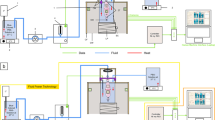PURPOSE
The aim of this study was to evaluate the efficacy of an absorbable polylactic acid film (SurgiWrapTM) in preventing postoperative intra-abdominal adhesions in an animal model.
METHODS
Forty-four female Sprague-Dawley rats underwent laparotomy with subsequent cecal wall abrasion and abdominal wall injury. Rats were divided equally between untreated and treated groups. Treated rats had a polylactic acid film (SurgiWrapTM) placed between the cecal and abdominal wall defects. Rats in the untreated group received no barrier material. The animals were killed on postoperative day 21. Two blinded observers, using predetermined criteria, graded the cecum-to-abdominal wall adhesions and estimated the percent of cecal surface area involved in the adhesion. The adhesions were classified as absent, moderate, or severe.
RESULTS
Four rats died postoperatively. Of surviving rats, all of the rats in the untreated group had cecum-to-abdominal wall adhesions, whereas 42.1 percent of rats in the treated group had no adhesions between the cecum and the abdominal wall (two-tailed, P = 0.001). Altogether, 28.6 percent and 71.4 percent of untreated rats experienced moderate and severe adhesions, respectively, compared to 47.4 percent and 10.5 percent of treated rats (two-tailed, P < 0.001).
CONCLUSIONS
Strategic placement of polylactic acid film during abdominal surgery is associated with a significantly reduced rate and severity of postoperative intra-abdominal adhesions in this model. A technique for film placement is suggested.


Similar content being viewed by others
REFERENCES
D Menzies (1992) ArticleTitlePeritoneal adhesions. Incidence cause, and prevention Surg Annu 24 27–45 Occurrence Handle1727325
H Ellis BJ Moran JN Thompson et al. (1999) ArticleTitleAdhesion-related hospital readmissions after abdominal and pelvic surgery: a retrospective cohort study Lancet 353 1476–80 Occurrence Handle10.1016/S0140-6736(98)09337-4 Occurrence Handle1:STN:280:DyaK1M3kslaksQ%3D%3D Occurrence Handle10232313
H Ellis (1997) ArticleTitleThe clinical significance of adhesions: focus on intestinal obstruction Eur J Surg Suppl 577 5–9 Occurrence Handle9076446
JF Hulka (1982) ArticleTitleAdnexal adhesions: a prognostic staging and classification system based on a five-year survey of fertility surgery results at Chapel Hill, North Carolina Am J Obstet Gynecol 144 141–8 Occurrence Handle1:STN:280:DyaL383otFGhug%3D%3D Occurrence Handle6214187
V Gomel B Urman T Gurgan (1996) ArticleTitlePathophysiology of adhesion formation and strategies for prevention J Reprod Med 41 35–41 Occurrence Handle8855074 Occurrence Handle1:STN:280:DyaK2s%2Fgslyitw%3D%3D
HG Saravelos TC Li (1996) ArticleTitlePhysical barriers in adhesion prevention J Reprod Med 41 42–51 Occurrence Handle8855075 Occurrence Handle1:STN:280:DyaK2s%2FgslyitA%3D%3D
DW Cahill GJ Martin SuffixJr MV Hajjar W Sonstein LB Graham RW Engelman (2003) ArticleTitleSuitability of bioresorbable cages for anterior cervical fusion J Neurosurg 98 195–201 Occurrence Handle12650405
R Dunn MD Lyman PG Edelman PK Campbell (2001) ArticleTitleEvaluation of the SprayGel adhesion barrier in the rat cecum abrasion and rabbit uterine horn adhesion models Fertil Steril 75 411–6 Occurrence Handle10.1016/S0015-0282(00)01677-0 Occurrence Handle1:STN:280:DC%2BD3M7ktlCnug%3D%3D Occurrence Handle11172849
MG Hull CM Glazener NJ Kelly et al. (1985) ArticleTitlePopulation study of causes, treatment, and outcome of infertility BMJ 291 1693–710 Occurrence Handle10.1136/bmj.291.6510.1693 Occurrence Handle3935248 Occurrence Handle1:STN:280:DyaL28%2FnvVCnsw%3D%3D
AM Kappas GH Barsoum JB Ortiz MR Keighley (1992) ArticleTitlePrevention of peritoneal adhesions in rats with verapamil, hydrocortisone sodium succinate, and phosphatidylcholine Eur J Surg 158 33–5 Occurrence Handle1:STN:280:DyaK383itlWqtQ%3D%3D Occurrence Handle1348638
AG Turkcapar C Ozarslan E Erdem C Bumin N Erverdi J Kutlay (1995) ArticleTitleThe effectiveness of low molecular weight heparin on adhesion formation in experimental rat model Int Surg 80 92–4 Occurrence Handle1:STN:280:DyaK2Mzos1emtw%3D%3D Occurrence Handle7657504
C Belluco F Meggiolaro D Pressato et al. (2001) ArticleTitlePrevention of postsurgical adhesions with an autocrosslinked hyaluronan derivative gel J Surg Res 100 217–21 Occurrence Handle10.1006/jsre.2001.6248 Occurrence Handle1:CAS:528:DC%2BD3MXntlOksbY%3D Occurrence Handle11592796
BW Hellebrekers GC Trimbos-Kemper CA Blitterswijk Particlevan EA Bakkum JB Trimbos (2000) ArticleTitleEffects of five different barrier materials on postsurgical adhesion formation in the rat Hum Reprod 15 1358–63 Occurrence Handle10.1093/humrep/15.6.1358 Occurrence Handle1:STN:280:DC%2BD3c3ptlaguw%3D%3D Occurrence Handle10831569
LE Claes AA Ignatius KE Rehm C Scholz (1996) ArticleTitleNew bioresorbable pin for the reduction of small bony fragments: design, mechanical properties and in vitro degradation Biomaterials 17 1621–6 Occurrence Handle10.1016/0142-9612(95)00327-4 Occurrence Handle1:CAS:528:DyaK28XkvFWis70%3D Occurrence Handle8842367
RK Kulkarni KC Pani C Neuman F Leonard (1966) ArticleTitlePolylactic acid for surgical implants Arch Surg 93 839–43 Occurrence Handle1:STN:280:DyaF2s%2FitFCrtQ%3D%3D Occurrence Handle5921307
K Bessho T Iizuka K Murakami (1997) ArticleTitleA bioabsorbable poly-l-lactide miniplate and screw system for osteosynthesis in oral and maxillofacial surgery J Oral Maxillofac Surg 55 941–5 Occurrence Handle10.1016/S0278-2391(97)90065-3 Occurrence Handle1:STN:280:DyaK2svktVWqtw%3D%3D Occurrence Handle9294503
WC Welch KA Thomas GB Cornwall et al. (2002) ArticleTitleUse of polylactide resorbable film as an adhesion barrier J Neurosurg 97 413–22 Occurrence Handle12449195
L Holmdahl B Risberg DE Beck et al. (1997) ArticleTitleAdhesions: pathogenesis and prevention – panel discussion and summary Eur J Surg 577(Suppl) 58
ACKNOWLEDGMENTS
The authors thank the Division of Veterinary Resources at the University of Miami School of Medicine, particularly clinical veterinarian Dr. Donna Avison and veterinary staff members Ms. Martha Mineau and Mr. James Geary for their dedication to maintaining the animals and to seeing that procedures in the operating room went smoothly.
Author information
Authors and Affiliations
Corresponding author
Additional information
Macropore Biosurgery, Inc. supported this work.
About this article
Cite this article
Avital, S., Bollinger, T., Wilkinson, J. et al. Preventing Intra-Abdominal Adhesions With Polylactic Acid Film: An Animal Study. Dis Colon Rectum 48, 153–157 (2005). https://doi.org/10.1007/s10350-004-0748-z
Published:
Issue Date:
DOI: https://doi.org/10.1007/s10350-004-0748-z




